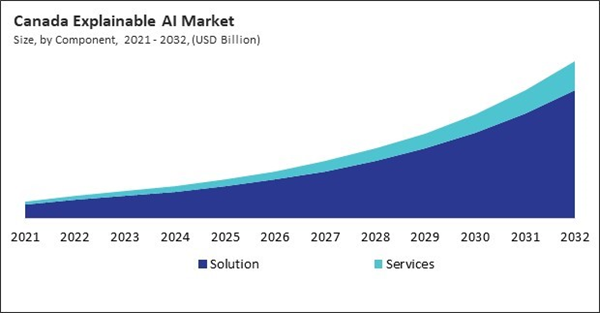The North America Explainable AI Market is expected to witness market growth of 19.6% CAGR during the forecast period (2025-2032).
The US market dominated the North America Explainable AI Market by country in 2024, and is expected to continue to be a dominant market till 2032; thereby, achieving a market value of $6.14 billion by 2032. The Canada market is experiencing a CAGR of 22.1% during 2025-2032. Additionally, the Mexico market is expected to exhibit a CAGR of 21.6% during 2025-2032.
Explainable AI finds application across a wide array of sectors, each harnessing its potential to ensure more trustworthy and actionable AI-driven insights. In the healthcare industry, XAI is instrumental in supporting diagnostic systems, treatment recommendations, and drug discovery. Clinicians increasingly demand transparency in AI-generated diagnoses, which directly affect patient lives; XAI provides explanations for predictions, boosting confidence and regulatory compliance. For example, when an AI system recommends a specific cancer treatment, explainability helps clinicians understand the underlying factors influencing the decision, such as patient history or particular biomarkers.
In the financial services sector, XAI is pivotal for credit scoring, fraud detection, and algorithmic trading. Regulatory requirements, such as the European Union’s General Data Protection Regulation (GDPR), mandate clear explanations for automated decisions, especially those affecting consumers. Banks leverage XAI to provide customers with clear rationales for loan approvals or denials and to justify trading decisions, ensuring adherence to legal standards while maintaining customer trust.
The United States leads the explainable AI market, underpinned by its robust technology infrastructure, dynamic startup ecosystem, and significant government investment. Explainable AI has become a strategic priority, especially as artificial intelligence finds applications in high-stakes sectors such as healthcare, finance, public safety, and defense. Early initiatives, such as the Defense Advanced Research Projects Agency (DARPA) Explainable AI program, set the tone for the market, signaling federal commitment to transparency and trust in machine learning. U.S. federal agencies, including the National Institute of Standards and Technology (NIST), have developed frameworks and guidelines emphasizing explainability as an essential element of trustworthy AI. The commercial sector has responded in kind, with leading OEMs like IBM, Microsoft, and Google embedding XAI features in their cloud and analytics offerings.
The US market dominated the North America Explainable AI Market by country in 2024, and is expected to continue to be a dominant market till 2032; thereby, achieving a market value of $6.14 billion by 2032. The Canada market is experiencing a CAGR of 22.1% during 2025-2032. Additionally, the Mexico market is expected to exhibit a CAGR of 21.6% during 2025-2032.
Explainable AI finds application across a wide array of sectors, each harnessing its potential to ensure more trustworthy and actionable AI-driven insights. In the healthcare industry, XAI is instrumental in supporting diagnostic systems, treatment recommendations, and drug discovery. Clinicians increasingly demand transparency in AI-generated diagnoses, which directly affect patient lives; XAI provides explanations for predictions, boosting confidence and regulatory compliance. For example, when an AI system recommends a specific cancer treatment, explainability helps clinicians understand the underlying factors influencing the decision, such as patient history or particular biomarkers.
In the financial services sector, XAI is pivotal for credit scoring, fraud detection, and algorithmic trading. Regulatory requirements, such as the European Union’s General Data Protection Regulation (GDPR), mandate clear explanations for automated decisions, especially those affecting consumers. Banks leverage XAI to provide customers with clear rationales for loan approvals or denials and to justify trading decisions, ensuring adherence to legal standards while maintaining customer trust.
The United States leads the explainable AI market, underpinned by its robust technology infrastructure, dynamic startup ecosystem, and significant government investment. Explainable AI has become a strategic priority, especially as artificial intelligence finds applications in high-stakes sectors such as healthcare, finance, public safety, and defense. Early initiatives, such as the Defense Advanced Research Projects Agency (DARPA) Explainable AI program, set the tone for the market, signaling federal commitment to transparency and trust in machine learning. U.S. federal agencies, including the National Institute of Standards and Technology (NIST), have developed frameworks and guidelines emphasizing explainability as an essential element of trustworthy AI. The commercial sector has responded in kind, with leading OEMs like IBM, Microsoft, and Google embedding XAI features in their cloud and analytics offerings.
List of Key Companies Profiled
- Microsoft Corporation
- IBM Corporation
- Google LLC (Alphabet Inc.)
- Salesforce, Inc.
- Intel Corporation
- NVIDIA Corporation
- SAS Institute Inc.
- Databricks, Inc.
- Amazon Web Services, Inc.
- SAP SE
Market Report Segmentation
By Deployment
- Cloud
- On-premise
By Component
- Solution
- Services
By Application
- Fraud & Anomaly Detection
- Drug Discovery & Diagnostics
- Predictive Maintenance
- Supply Chain Management
- Identity, Access Management & Others
By End-Use
- IT & Telecommunication
- Healthcare
- BFSI
- Aerospace & Defense
- Retail & E-commerce
- Public Sector & Utilities
- Automotive
- Other End-use
By Country
- US
- Canada
- Mexico
- Rest of North America
Table of Contents
Chapter 1. Market Scope & Methodology
Chapter 2. Market at a Glance
Chapter 3. Market Overview
Chapter 4. Competition Analysis - Global
Chapter 5. Value Chain Analysis of Explainable AI Market
Chapter 7. North America Explainable AI Market by Deployment
Chapter 8. North America Explainable AI Market by Component
Chapter 9. North America Explainable AI Market by Application
Chapter 10. North America Explainable AI Market by End-use
Chapter 11. North America Explainable AI Market by Country
Chapter 12. Company Profiles
Companies Mentioned
- Microsoft Corporation
- IBM Corporation
- Google LLC (Alphabet Inc.)
- Salesforce, Inc.
- Intel Corporation
- NVIDIA Corporation
- SAS Institute Inc.
- Databricks, Inc.
- Amazon Web Services, Inc.
- SAP SE









